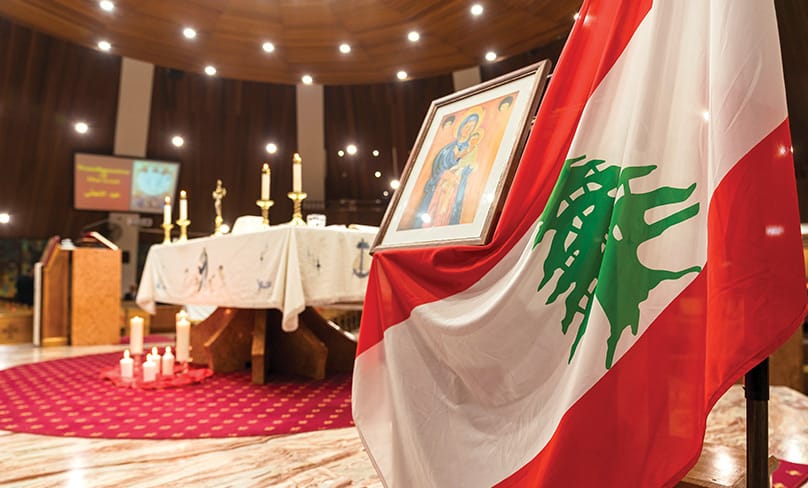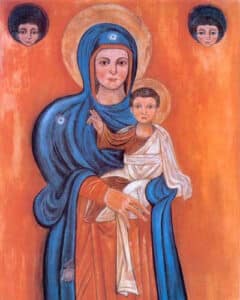
A strong devotion to the Virgin Mary is stamped on each Maronite soul. In Lebanon, home to the Maronites for centuries, its glorious cedars have been honoured with comparisons to Our Lady’s strength and beauty.
Fr Godard SJ, a nineteenth century missionary to Lebanon, wrote, “Lebanon is the only country in the world to have deserved, by merit of its beauty and charm, this comparison to [Mary] the most radiant of creatures.”
Our Lady, or Adra (Virgin) as she is lovingly called, is never far from a Maronite’s lips.
Before or after the Divine Liturgy is celebrated, it is commonplace for the faithful to venerate her icon and recite the ZiaH al-Adra, a traditional hymn which honours her as Mother of God. The rosary and litany are prayed faithfully.
Even the simpler and most ordinary souls know to call upon Mary, certain that the same mother who interceded for the wedding servants at Cana will also intercede for them and lead them to her son.
This kind of devotion to the blessed mother is characteristically Maronite. But where does this devotion come from, and why is it so embedded in our spirituality?
For all the Maronite saints, Mary was at the centre of their spirituality.
St Charbel, the angelic hermit and priest, loved Our Lady deeply. As a child, he would go missing for hours, being found deep in prayer in a nearby cave he had dedicated to Mary.
At 23, he left his home in secret to become a monk, without even saying goodbye to his mother whom he loved so much.

This uniquely Syriac inspired Maronite art that is more than 1000 years old, and was the Maronite Patriarch’s personal icon. It has travelled with generations of Patriarchs, wherever Maronites moved to flee persecution. The icon is given its name following its discovery in the Church of Our Lady of Ilige (Mayfouq, Jbeil district, Lebanon), which had been the refuge and home of the Maronite Patriarchs from the 12th-15th Century.
Just like the infant Jesus who was lost for three days, Charbel chose to dwell in the house of God to do his Father’s work. Mary would become his mother, as he promised to leave all things behind—even his own family—to serve God.
As a monk and hermit he prayed the rosary daily, and even a passing mention of the name of Mary warmed his heart. He consoled the sick and dying, reassuring them, “Are you not then the beloved child of the immaculate mother?”
We see a similar devotion in the life of the holy nun, St Rafqa. Losing her mother at a young age, Our Lady became Rafqa’s mother and guide in all things. She imitated Mary’s obedience and sacrifice in her life.
Like Mary, she was a handmaid of the Lord, dedicated to serving her people and obeying her superiors. With the Psalmist she could say, “I delight to do thy will, O my God; thy law is within my heart” (Psalm 40:8).
Like Mary, she stood firm at the foot of Christ’s cross, suffering from constant headaches, blindness and paralysis for almost 30 years.
St Nehmetallah’s spirituality was also built on his love for Jesus and devotion to the blessed mother. His brother monks often observed him praying the rosary on his knees in the chapel, totally absorbed in meditation.
Fr Paul Daher OLM described St Alphonsus Liguori’s work The Glories of Mary as Nehmetallah’s “missal,” from which he drew inspiration to imitate Our Lady’s love for Jesus Christ and commitment to the Gospel.
His dying words were, “O Virgin Mary between your hands I submit my soul.”
Yet our devotion to Mary can sometimes be misunderstood. Often, it is mistaken for worship or idolatry, but this could not be further from the truth.
Since the earliest days of the Church, Christians have taken spiritual guides to imitate in their journey with Jesus. St Paul instructed the Corinthians, “Be imitators of me, as I am of Christ” (1 Cor 11:1).
If St Paul is worthy of imitation, how much more, then, is the woman who bore Jesus and raised him?
Maronites go to Mary with confidence because God himself entrusted Mary with his only son. We do not love her more than God. It is Mary who inspires us to love God more.
In persecution, famine, tribulation and distress, she has interceded for the Maronite Church as with other churches too, and all generations will indeed call her blessed (cf. Luke 1:48).
Joseph Boulos is spiritual coordinator of UniMaronite, an intervarsity movement that helps tertiary students grow in their Maronite faith.
